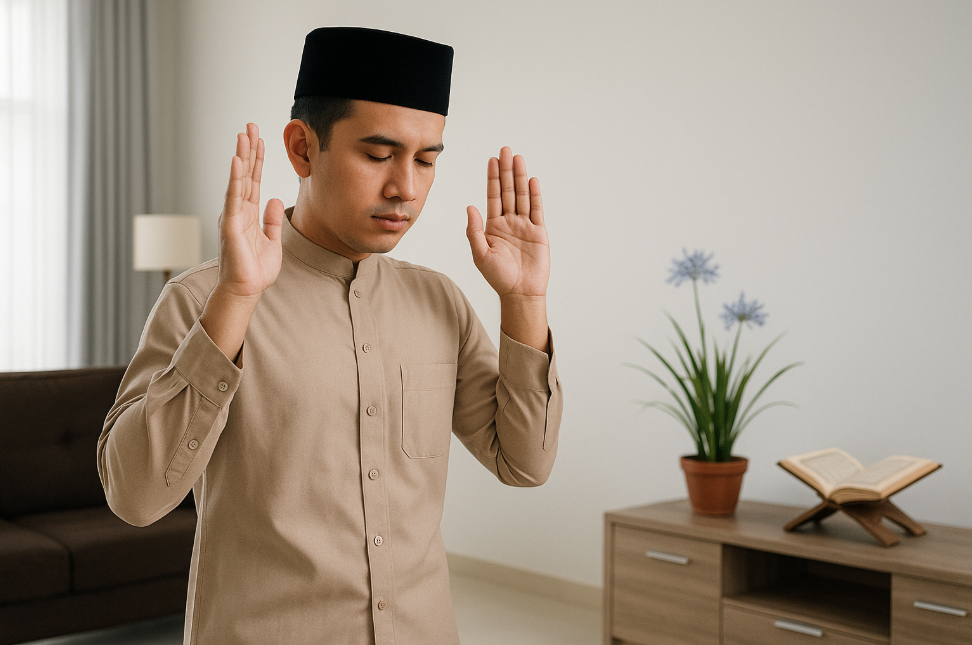Question
Rafʿ al-Yadayn (raising the hands) in prayer: What are the solid references? Do I need to follow one of the four madhhabs? Is it restricted? What’s its origin, and what’s the proper way to practice it?
Short Summary
Rafʿ al-Yadayn is a confirmed Sunnah at four points:
-
The opening takbīr (Takbīrat al-Ihrām)
-
Before rukūʿ
-
After rising from rukūʿ
-
When standing for the third rakʿah after the first tashahhud
Shāfiʿī and Ḥanbalī jurists uphold all four; Ḥanafīs restrict it to the opening takbīr; Mālikīs vary. Both patterns are valid and based on authentic Sunnah.
Key Points
-
Evidence: Multiple ṣaḥīḥ narrations from Ibn ʿUmar and Mālik b. al-Huwayrith.
-
Scope: Four points only not in sujūd or between the two sujūd.
-
Madhhabs: All accept it as Sunnah; differences are in frequency and application.
-
Method: Hands to shoulders or ears, palms toward qiblah, fingers naturally apart, with the takbīr.
-
Origin: Direct Sunnah of the Prophet ﷺ transmitted by many Companions.
Evidence from the Sunnah
ʿAbdullāh ibn ʿUmar (RA) said:
“The Messenger of Allah ﷺ used to raise both hands to shoulder level when opening the prayer, on saying the takbīr for rukūʿ, and on raising his head from rukūʿ, and he did not do that in the prostrations.”
(Ṣaḥīḥ al-Bukhārī, 735; Ṣaḥīḥ Muslim)
In another narration:
“…and when he stood up after two rakʿahs, he raised them likewise.”
(Bukhārī, Kitāb al-Adhān)
Mālik b. al-Huwayrith (RA) reported:
“He raised his hands until they were in line with his ears” at the opening takbīr and at rukūʿ.
(Bukhārī; Muslim 390–392)
Scholarly Positions
All four agree Rafʿ al-Yadayn is Sunnah; differences are in frequency.
Restriction of the Sunnah
It is restricted to the four positions above. It is not legislated in sujūd, between the two sujūd, or at every movement in the prayer.
Origin of the Practice
Its origin is the Sunnah of the Prophet ﷺ, witnessed by Companions such as Ibn ʿUmar and Mālik b. al-Huwayrith, preserved in the Ṣaḥīḥayn.
Imām al-Bukhārī even authored a dedicated work, Juzʾ fi Rafʿ al-Yadayn, affirming that all the Companions practiced it and that no authentic report exists of any abandoning it.
Proper Method
-
Height: To the shoulders or alongside the ears (both authentic).
-
Fingers: Naturally apart.
-
Palms: Facing the qiblah.
-
Timing: Raise with “Allāhu Akbar” and lower after.
-
Instances:
-
Opening takbīr
-
Before rukūʿ
-
After rising from rukūʿ (“Samiʿa-Allāhu liman ḥamidah”)
-
When standing for the third rakʿah after the first tashahhud
-
Additional Clarification
Weak and fabricated reports used to oppose the four-point raising are rejected by the scholars. The strongest authentic narrations support the four-point Sunnah.
Practical Guidance
If you already follow a madhhab, remain consistent. If not, both patterns opening-only or all four points are Sunnah-based. Choose one and maintain khushūʿ in your prayer.
What This Means for You
Both approaches are valid. Raising at all four points follows explicit ṣaḥīḥ evidence; raising only at the opening takbīr follows a recognized scholarly position. Choose one method, avoid unnecessary switching, and focus on humility and presence in prayer.
And Allah knows best.
References
- Ṣaḥīḥ al-Bukhārī: 735; Kitāb al-Adhān (raising after two rakʿahs)
- Ṣaḥīḥ Muslim: 390–392
- Imām al-Nawawī, al-Majmūʿ
- Ibn Qudāmah, al-Mughnī
Was this helpful?
Leave Your Comments
© Copyright 2025, All Rights Reserved

